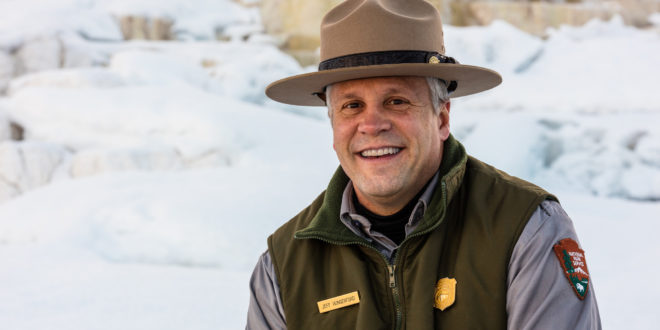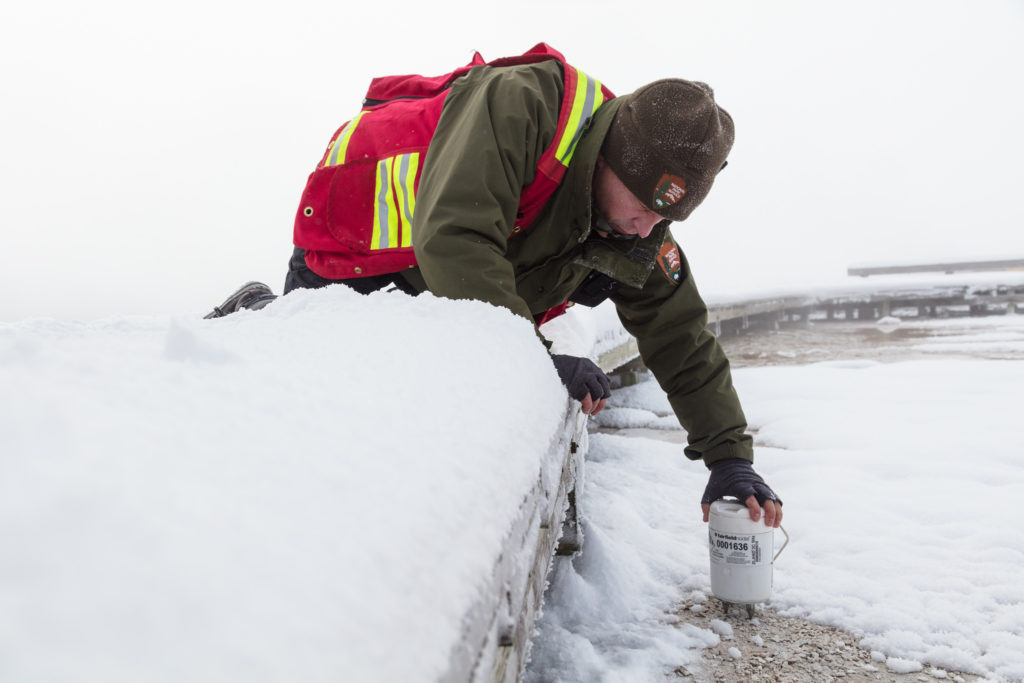For anyone worried about the Yellowstone volcano exploding, take heart—the park geologist isn’t too worried about it.
“I live in the park, and I don’t have any plans on leaving anytime soon,” Yellowstone National Park Geologist Jeff Hungerford said recently.
Hungerford said there would be obvious signs prior to an eruption. The deformation, or swelling, of the volcano would increase immensely, gas emissions would “go through the roof” and there would be seismic activity different from the small, nearly-daily and mostly unfelt tremors that occur nearly daily.
“People are safe. Come and enjoy your park,” Hungerford said. “We’re not going to see an eruption in our lifetime.”
Hungerford is a trained volcanologist who earned his Ph.D. at the University of Pittsburgh. He came to Yellowstone from the United States Geological Survey Cascades Volcano Observatory in Vancouver, Washington. He caught his passion for volcanoes early while growing up in Hawaii. He has worked on USGS projects in Yellowstone in the past.
“It’s been a long-time love for me,” he said. “For a geologist [Yellowstone] is kind of a mecca. I love it.”
Hungerford has been the park’s geologist for a little over a year, following the retirement of the most recent park geologist, Hank Heasler.
He spoke about the “dynamism” of park thermal features, of how quickly things can change. He noted that Echinus Geyser, which had been erupting fairly regularly this fall, has already ceased erupting. Echinus was a fairly predictable crowd-pleaser at Norris Geyser Basin for many years before 2001. According to a recent posting on the park’s Facebook page, Echinus resumed eruptions from Sept. 13 to Nov. 11.
Asked what an average day in the life of a park geologist looks like, Hungerford laughed and said he’s still trying to figure out what an average day is. His work includes working in the field, perhaps installing data monitoring devices in geyser basins (see above, where Hungerford is installing a sensor on Geyser Hill) or working with data compiled by sensors.
He said his goals for his work embrace two overarching themes—keeping visitors safe and preserving the geothermal system as well as continuing to add to the collected data around the geysers and volcano.
“I’d love to build a fantastic and world class monitoring system with my cohorts with the Yellowstone Volcano Observatory,” Hungerford said. “I’d like to get through all the collected data we have here.”
The YVO is a USGS project based in Menlo Park, California that monitors the park.
Hungerford praised the geyser data and observations provided by volunteer and amateur “geyser gazers,” people who love thermal features and keep, in some cases, meticulous notes and data.
“I wish I could get these people to write journal articles because a lot of the data is just fantastic,” he said.
Another of Hungerford’s goals is to keep both people and thermal features safe.
“We have to make sure we’re good stewards of this area,” Hungerford said. “As dangerous as these areas are, they’re also very fragile. It’s imperative people stick to boardwalks and trails. If people veer off, areas get degraded pretty quickly.”
Hungerford wouldn’t quite commit to a favorite geyser or geyser basin, but did admit he liked Little Squirt geyser, which is located in the Upper Geyser Basin near Old Faithful.
“I love Beehive, too,” he said.
Hungerford enjoys getting out and interacting with the public.
“Being out in the field in thermal areas and recognizing all the energy being exhibited in all the heat and recognizing where it’s coming from is an expression of the volcanic system,” he said. “For all volcanologists, that’s the core thrill of life. It’s also fun chitchatting with people on the boardwalks and seeing their engagement and joy. “It’s fun to share smiles with a lot of very happy people. There are a lot of ‘best’ things in my job.”
Another of Hungerford’s jobs is to help out with situating trails and boardwalks in thermal areas.
“We map [the trails] out and make sure they’re in the coolest area possible,” Hungerford said, laughing, indicating both the coolest area regarding temperature as well as “cool” in the awe-inspiring sense.
Hungerford agrees that Yellowstone inspire passionate fans from all times and from all over the world.
“Since the European [colonizers] and First Nation cultures, we’ve had a reverence for these features that were out of the ordinary,” Hungerford said. “Yellowstone captures our imagination with its immense conglomeration of geology and biotic realm. It’s so big and it makes you feel minuscule and grabs you with that awe.”
 Yellowstone Insider Your Complete Guide to America's First National Park
Yellowstone Insider Your Complete Guide to America's First National Park







You must be logged in to post a comment.